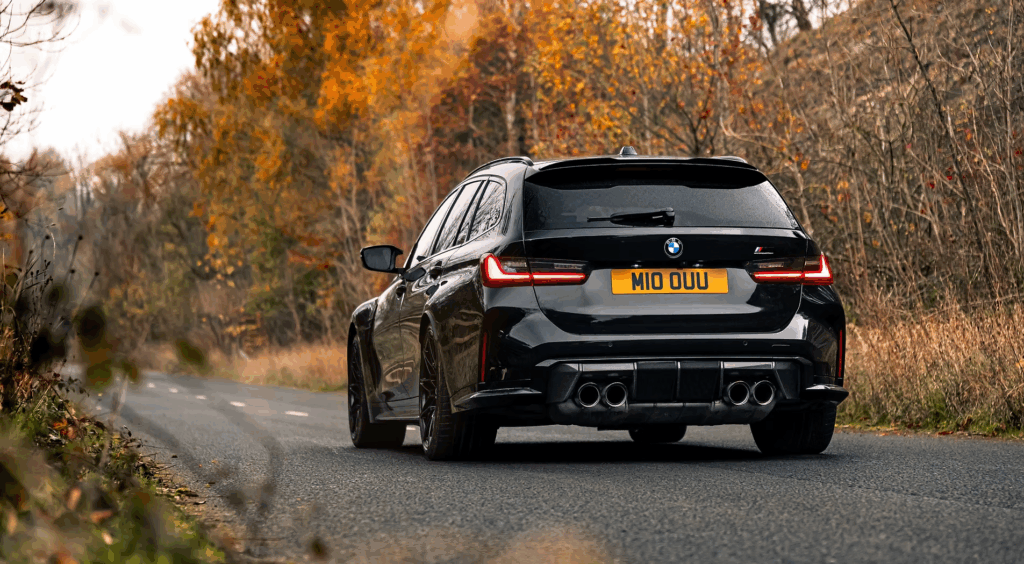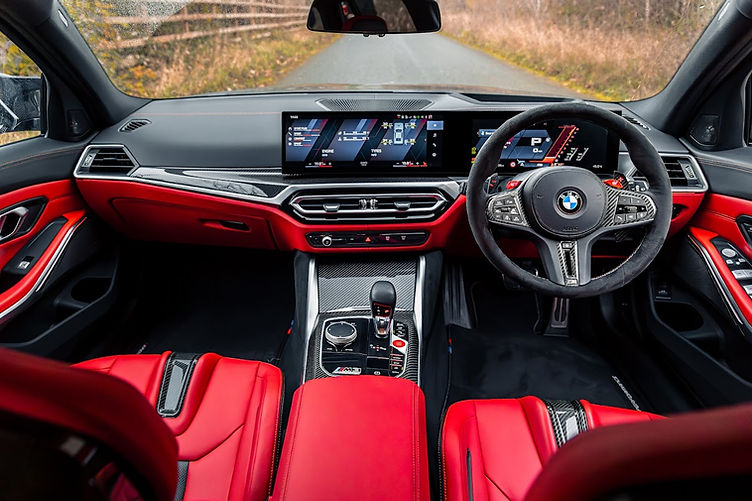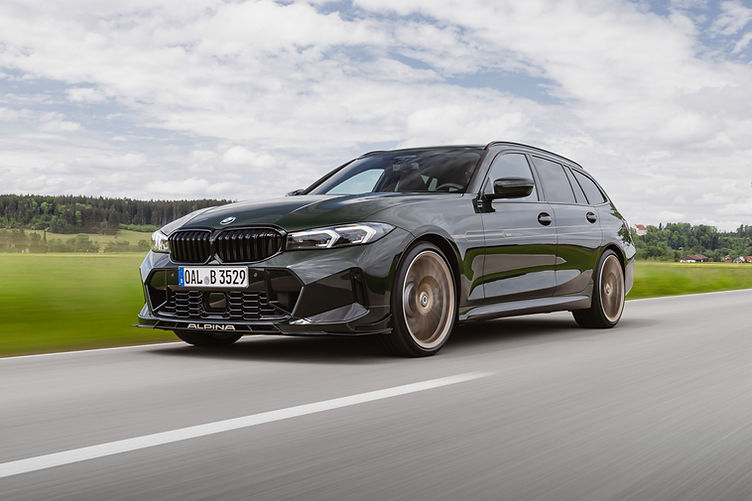THE T(O)URING TEST – BMW M3 Touring Review
BMW has finally relented to demands and given us an M3 Touring. Craig Toone gets behind the wheel and puts the car to the test. Will the car live up to the hopes and dreams of M enthusiasts?
It seems like every BMW man and his dog has been waiting decades for an M3 Touring. After all, both the M3 and the Touring body shell made their debuts with the E30 in the 1980s, and given the M3 has appeared in coupe, cabriolet and saloon form over the years, a Touring variant feels like the missing piece. And yet, for some unknown reason, the M division has always resisted delivering one.

Maybe there has always been some unspoken understanding between Munich, Stuttgart and Ingolstadt: leave the coupe to the M division, the saloon to AMG and, of course, the estates to Audi. Each manufacturer gets to trumpet its own fiefdom of Teutonic superiority.
Whatever the reasoning, BMW has clearly thought about an M3 Touring before, teasing us with the E46 concept now locked away in some bunker deep within M HQ. That car planted a seed within M enthusiasts, leaving them impatiently waiting for an M3 Touring to germinate. (Check out our Short Shift article on that car for more.)
Two decades after that concept – and almost four since the E30 M3 broke cover in 1986 – that seed has finally borne fruit. But now that it has, the G81 Touring is a hard car to warm to if you classify yourself as a traditional M-lover. Gone is the bespoke, high-revving motorsport-inspired engine of yore, replaced by a modular motor packing big boost. The purity of rear-wheel drive has given way to four-wheel drive, and an eight-speed torque converter automatic now sits where a DCT or manual once lived. Worse still, BMW’s efforts to build the lightest car in the class by a significant margin have fallen by the wayside; travel two-up or get fancy with the options list, and the M3 Touring will surpass two metric tonnes – not to mention breach six figures in price.


It’s a lot to take in. I might sound pedantic, but these details matter to fans of the marque. An M car has always had that extra sprinkling of engineering magic that gives its products a specialness that leaps off the spec sheet and transfers itself to the driving experience. And that’s before we talk about the way the car looks, which continues to divide opinions. Time nor familiarity hasn’t diluted its brutalism.
I’m not sure if Frank Van Meel, boss of the M division, has a favourite Star Wars movie, but you’d imagine he might be a fan of The Last Jedi. Perhaps he’d sympathise with Kylo Ren’s line: “Let the past die. Kill it, if you have to.” Such has been the online crowing for the ‘glory days’ of the E46 M3, or the fat-shaming of the new G90 M5.
But we live and operate in a different world – one in which the M cars of legacy can no longer exist. Porsche and Ferrari can get away with specialist high-revving naturally aspirated engines in limited-run sports and supercars, but the M division can’t – certainly not with a volume seller like the M3. Besides, even Formula One cars are turbocharged. Turbos are motorsport these days, and that’s what M stands for, right?

Despite any purist misgivings about turbochargers, even in super-slippery conditions, the engine dominates proceedings. Let’s just say 503bhp at 6,250rpm is more than sufficient. To be honest, I suspect there’s a typo in the BMW spec sheet because the output feels closer to 530bhp – a suspicion owner Phil confirms by quoting the 537bhp and 513lb/ft of torque the car produced on RS Tuning’s “heartbreaker” dyno.
Yes, it’s completely docile when called for; however, the first full-bore standing start is enough to take your breath away. The M3 has mighty straight-line pace – any condition, any gear. We’re talking 0–100mph in 7.5 seconds. Phil has logged the car hitting 60mph in 3.3 seconds and covering 100–200km/h in 8.6 seconds using his Racebox GPS.
Even the piped-in engine noise has a feeling of authenticity about it. Instead of sounding like a synthetic six, it growls like a proper Munich straight-six. It’s raw, responsive and exciting – the clarity between octaves is a far cry from the early monotone system that augmented the F10 M5’s V8, a car that, frankly, sounded better in Gran Turismo than in real life.

But in give-and-take driving, it’s the S58’s torque, peaking between 2,750 and 5,500rpm (with useful shove from as low as 2,250rpm), that matters most. At first, you’ll instinctively short-shift at 5,500rpm and still make indecent progress. But you’ve got the best part of another 2,000rpm to play with. The engine isn’t done – it’ll spin to 7,200rpm and get there with alarming speed, but such is the level of mid-range go, you’ll rarely feel the need to rev the car right out, instead picking off gears with the paddles.
Whether the way the engine charges to the redline so feverishly is down to its responses or super-short gearing, I couldn’t say, but second gear is rendered near-enough useless on a back-road blast. The only time you’ll feel any lag is when the car is left to its own devices, quickly slurring shifts into a high gear, and you suddenly demand 20% more. Below 2,000rpm, it will struggle.
What happens when you demand more? Despite the M3 Touring’s size and mass, you can truly hustle this car down a tight and twisty B-road. Third and fourth are the gears you’ll surf between, and such is the pace, agility and strength of the bodyshell, it weirdly calls to mind the GR Yaris. You feel every nuance of the road surface beneath you, yet remain confident in the car’s ability to soak it all up.
The body control and damping are exceptional. Yet, such is the M3’s pace across the ground, there is an odd queasiness to the ride quality at times as the dampers contend with rapid-fire inputs. Perhaps this quirk stems from the bucking, rippled surface of the Yorkshire B-roads we’re on because, on smoother tarmac, the M3 demonstrates nothing but supreme poise.

To ensure the Touring variant delivers dynamically, the M division has reinforced the centre and rear sections of the body with model-specific underfloor bracing elements, a new cross-bar, increased load compartment stiffness, and a bespoke rear subframe with a rigid connection to the body – as per the M3 saloon and M4 coupe. One element that hasn’t made the transition, however, is the signature carbon-fibre roof.
What’s for certain is there is no chance you’d drive the spiky, previous-generation F80 M3 in the manner of this car. Far from corrupting the chassis, all-wheel drive has proven to be the making of the M3. The G8X is a genuinely throttle-adjustable car thanks to the xDrive system. The intent of the four-wheel-drive system isn’t solely to channel every bhp into forward momentum – it’s also to entertain and embellish.
It might be software wizardry plying its trade at lightning speed via microchips, but here’s the crux – it never feels artificial or contrived, just fun and, dare I say, agile. The grin widens the harder you push, and the more you push, the more involved you feel. Turn-in is impressive for a car of this size and weight, but the truth is, that’s merely a prelude to the real reward – overspeeding the rear tyres post-apex. If all-out competence is what you’re after, particularly in challenging conditions or on unfamiliar roads, leaving xDrive in “4WD Normal” mode will see it out-Quattro an RS4 without breaking a sweat.

Traction and exploitability aside, the next biggest improvement is the electric power-assisted steering. BMW EPAS has come on leaps and bounds since the F87 M2 – the numbness is gone. Now there’s a more natural weighting, greater response just off-centre, and genuine feedback. Even in such greasy conditions, the confidence it inspires is undeniable.
I’d like to highlight the gearbox again for a moment. Specifically, the shifts themselves rather than the spacing of the ratios. A DCT would undoubtedly be snappier and more aggressive, but I honestly cannot fault the ZF eight-speed. No road test has ever slated the same gearbox in the Alfa Romeo Quadrifoglio, so surely BMW gets a pass here too. The seats deserve a mention as well. They look fantastic and feel equally great – comfortable when cruising, vice-like when driving with intent – but only once you’re safely ensconced.
Negotiating the unforgiving carbon-clad sill, however, is another matter entirely. No doubt these seats will become a must-have item. Resistance to leaving that option unticked is futile. The driving position itself is excellent; you’re anchored low in the car, and the curved screen dash is well thought out, complete with a cool M1 graphic for tyre pressures. At first, the Touring feels like a big car – the extremes are hard to judge – but piloting it soon becomes second nature.



The M3 Touring has the ability to tackle anything you ask of it with utter competence. But does such a breadth of talents mean the adrenaline rush masks a lack of tactility? Could the M3 Touring’s showroom party-trick dynamics wear thin over a longer ownership stint? Any drawbacks are more about day-to-day living than the driving experience itself. Phil, who’s migrated from an M340i Touring to the M3, notes how, as a car of the moment, the M3 Touring draws a lot of attention. He admits the ride is noticeably firmer, and he’s somewhat surprised that, despite their engines sharing DNA, weighing roughly the same, and utilising the same gearbox, the M3’s mpg is significantly worse – even when driving with restraint.
While it’s true that some of the specialness of earlier M cars has inevitably been eroded – how could it not be – there is no doubt in my mind that the M3 Touring is a bona fide M car. It lives up to every hope, delivering everything you could ever need from a car. It’s good enough to convert the entire family it transports into petrolheads.
The blueprint of M might’ve evolved, but the M3 Touring immerses the driver in prodigious performance that remains unmistakably M, putting fresh air between it and any rival. And then, when you’ve had your fix, a single press of a button transforms it into a relaxing companion. It’s up there with Munich’s finest. Bravo, BMW. What took you so long?

2024 BMW M3 Touring Specification and Performance
Performance
Engine: 3.0-litre twin-turbocharged inline-six (S58)
Power Output: 503bhp at 6,250rpm
Torque: 479lb/ft (650Nm) between 2,750 and 5,500rpm
0–62mph (0–100km/h): 3.6 seconds
Top Speed: Electronically limited to 155mph (250km/h); increases to 174mph (280km/h) with the optional M Driver’s Pack
Transmission and Drivetrain
Gearbox: 8-speed M Steptronic automatic with Drivelogic
Drivetrain: M xDrive all-wheel drive with Active M Differential;
Configurable in 4WD, 4WD Sport, and 2WD modes
Dimensions
Length: 4,801mm
Width: 1,903mm
Height: 1,446mm
Wheelbase: 2,857mm
Unladen Weight (DIN): 1,865kg
Fuel Economy and Emissions
Combined Fuel Consumption: Approximately 27.4mpg (10.3 L/100km)
CO₂ Emissions: 234 g/km
Pricing
Starting Price: £87,945
Optional Packages:
M Pro Pack (£7,995) includes carbon-ceramic brakes;
Ultimate Pack (£11,250) adds features like carbon bucket seats
Interior and Technology
Infotainment: 14.9-inch control display with BMW Live Cockpit Professional
Cargo Capacity: 500 litres (seats up)
Chassis and Suspension
Suspension: Adaptive M suspension with electronically controlled dampers
Brakes: M Compound brakes; optional M Carbon ceramic brakes
Wheels: 19-inch front and 20-inch rear alloy wheels
Subtly does it: The new Alpina B3 GT and B4 GT

Not every performance car needs to shout about its abilities, as Alpina has displayed with its latest three models. Ken Pearson uncovers all the subtle details.
Alpina have done it again, showing that high performance doesn’t need to come at the cost of subtlety or refinement – making the new B3 GT Saloon, B3 GT Touring and B4 GT a trio of fabulously understated outliers in a performance segment filled with overtly aggressively styled models. I like sleepers that don’t shout about their performance, and at first glance you could be forgiven for not expecting these cars to come with 522 bhp and 538 lb ft (730 nm) at their disposal, unless you know what you’re looking for.
The base of the front bumper sees a new splitter that contains the ALPINA wordmark in the centre, and subtle extensions with black-painted canards on the outer edges. The B3 GT has a wide hexagonal lower grille with intakes that divert air to hidden radiators, while the B4 GT has that tall kidney grille with a sea of silver bars and exposed outer radiators. Air channels feature on both cars that take air into the front wheel arches to reduce the turbulence caused by the magnificent 20” Classic forged alloy wheels when turning.
These are standard on the GT trio and are finished in a gold colour known as Oro Tecnico, with a diamond cut silver strip on and between each of the 20 spokes. Model-specific lettering also appears on the face of the wheel.




Gold pinstriping can stretch from the front wheel arches to meet the rear lights, providing a nice contrast to a dark exterior colour, or another subtle detail if white or grey paint is selected. At the rear, there’s another Alpina-specific splitter with quad-exit exhausts sitting either side of a four-strake diffuser, both finished in black. Model badging is gold, matching the wheels and the side striping. The B3 GT Saloon and B4 GT gain a pronounced lip spoiler on their bootlids…and that’s it. The Alpina GTs are refreshingly subtle and understated to my eyes, only dropping the slightest hints as to what lays within the engine bay.
The 522 bhp and 538 lb ft on offer comes from Alpina’s reworked version of the BMW S58 engine – the very same one that powers the M3 and M4. While this falls short of the M3 and M4 by 1 bhp, the Alpinas benefit from an extra 59 lb ft (80 Nm), with peak torque available from 2,500 – 4,500 rpm. The reworked engine mapping, which has gifted the car with an extra 34 bhp compared to its predecessor, is said to ensure that maximum performance is available in every driving situation, meaning for effortless progress when driving gently or rapid acceleration when you need to get a wiggle on.
The 0-62 mph times for all models begin with three; 3.4 seconds for the Saloon, 3.5 for the Touring and Gran Coupé. Keeping your foot down, 124 mph arrives in 11.6, 12.0 and 11.9 seconds for the Saloon, Touring and Gran Coupé respectively. Those of you who know your stats will recognise that the B3 GT Saloon’s acceleration times are ever so slightly quicker than those of the new M3! The GTs will keep on accelerating past the M3’s top speed, with 190 mph attainable.




Making the performance usable is an Alpina-specific version of the ZF 8-speed automatic transmission and a rear-biassed all-wheel drive system with an electronic limited slip differential at the rear. All of these changes are visible on a specification sheet, but some of the tweaks made to the chassis can be seen by opening the bonnet where you’ll be greeted with a pair of bulkhead reinforcement struts that increase rigidity and naturally, they’re painted gold.
New shock absorbers make their way to the B3 GT to take advantage of the stiffer chassis, but Alpina is keen to stress that improved handling does not come at the expense of ride comfort. The B4 also gets a retuned chassis, but one that is focussed on enhancing agility. This features new stabilisers with reinforced mounts at the front, leading to the steering and adaptive damping setups to be changed.
As the old saying goes: “When one bonnet closes, a door to the cabin opens”…or something like that. Anyway, that’s my smooth segue to start talking about the interior, which takes the same dual curved screen layout as the new 3 and 4 Series models, but with an Alpina-specific theme for the iDrive infotainment system. Carbon fibre trim is standard, along with Performtex velour upholstery for the seats, but what you really want is the leather that Alpina is famous for. Merino leather can be added to the seats and dashboard, while the LAVALINA option can see everything from the seat backs, centre console, door pulls and the piping on the floor mats be clad in leather. Yes please.




Regardless, the flat-bottomed steering wheel is finished in the soft LAVALINA leather with a subtle GT badge located beneath the airbag. The Oro Tecnico gold trim theme of the exterior continues inside with the colour appearing on the contrast stitching for the steering wheel, floor mats and headrest-mounted GT lettering, along with the aluminium shift paddles.
As with the exterior, Alpina-specific touches are hidden in plain sight, with the Alpina logo taking pride of place on the steering wheel, but also appearing on the carbon fibre dashboard trim and the floor mats. Next to the parking brake button is one of the two chassis plates that confirms the model and its build number. The other one is under the bonnet, ahead of the engine.
The GTs are filled with subtly special touches that separate them from the models that they’re based on, like the ALPINA wordmark on the gearshift paddles and the wheel hubs (yes, seriously), and the GT lettering on the door sills with a design that mimics the exterior stripes. They’re all hidden in plain sight on the cars and have been throughout this article too. It’s these details, along with the comfort-focussed performance ethos and subtle styling that make Alpinas such an appealing proposition to me.



For a car with impressive performance, styling and upholstery like this, it’s only natural for it to come with an impressive pricetag to match. These begin at £89,300 for the B3 GT Saloon, £90,400 for the B3 GT Touring and £91,400 for the B4 GT. The standard equipment is virtually identical with the estate getting a split-opening tailgate and the B4 gaining radar-guided cruise control which is an option on the B3s.
Naturally, I’ve been on the configurator and managed to inflate a Ken-spec B3 GT up to £111,750 with my choice of Alpina Green paint, the extended LALVALINA leather interior, adaptive headlights and head-up display contributing to the slight price lift. Deliveries are expected to begin in early 2025 for the UK market.
The trio of new GT models from Alpina are right up my street; I live in a part of the country that is prime M3 and M4 territory, so there’s something refreshing about the prospect of a car that can complete the task of rapidly devouring miles without turning heads or batting an eyelid. Alpinas are meant to fly under the radar, but I will be scanning the roads for these.



